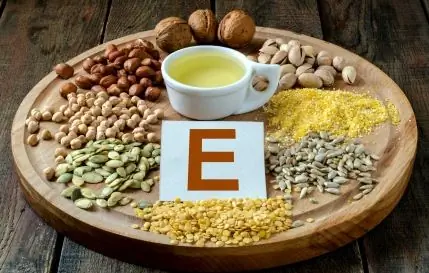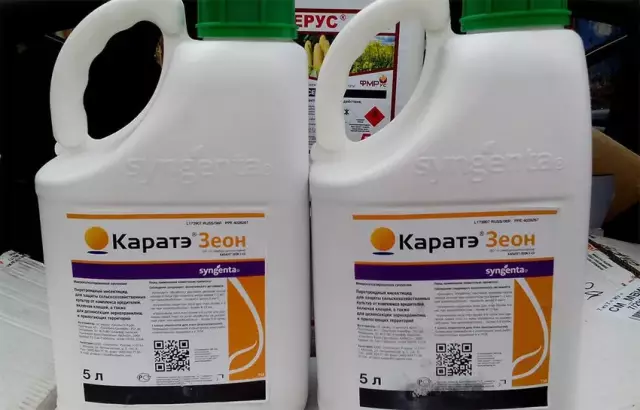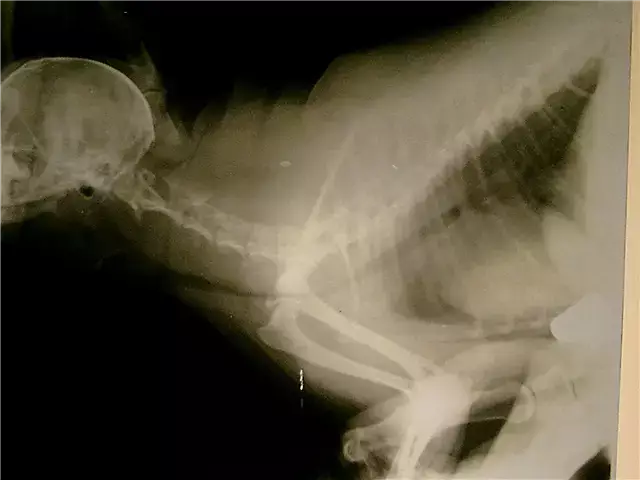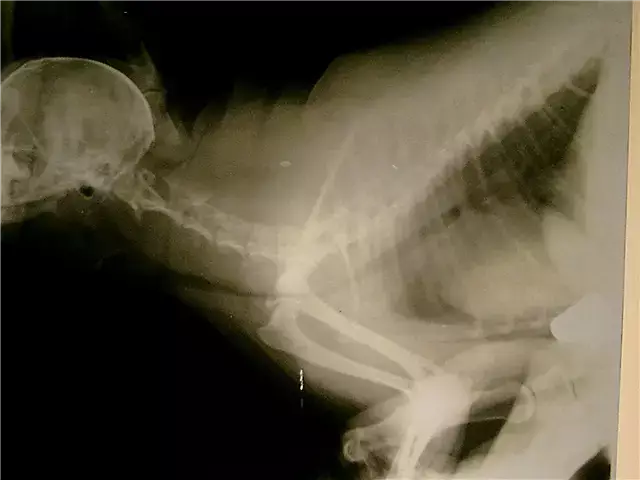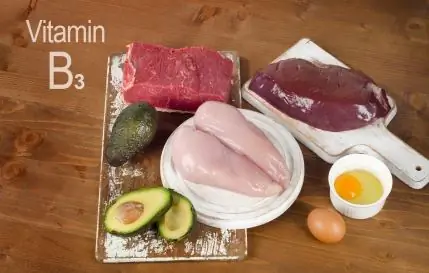- Author Rachel Wainwright [email protected].
- Public 2023-12-15 07:39.
- Last modified 2025-11-02 20:14.
Vitamin E
Vitamin E - Tocopherol, an antioxidant, fat-soluble vitamin. Tocopherol was discovered in 1922 and ranked fifth in alphabetical classification. Hence the name - vitamin E.

In the course of studies, it was found that its lack in the diet of laboratory rats led to the fact that during pregnancy they died of the fetus, and in males testicular atrophy occurred.
Lack of vitamin E leads to metabolic disorders, the development of local oxygen starvation due to a decrease in the ability of the blood to transfer oxygen. Tocopherol deficiency leads to the destruction of red blood cells due to a violation of the stability of their membranes.
The role of tocopherol in the body
Tocopherol is essential for tissue regeneration, improves blood circulation, helps in the treatment of fibrotic breast diseases, and is useful for premenstrual syndrome. It promotes normal blood clotting and accelerates healing, reduces the likelihood of deep wound scarring, stabilizes blood pressure, prevents cataract development, relieves leg cramps, prevents anemia, maintains muscle and nerve health, improves athletic performance, and strengthens capillary walls.
Vitamin E is good for hair. It is believed that in almost 80% of hair loss cases, the cause is precisely a lack of tocopherol. Tocopherol is responsible for delivering oxygen to the scalp, improving blood circulation, stimulating, nourishing and moisturizing skin cells. Thus, the application of vitamin E to hair improves its condition and growth. Their structure improves, shine appears, and curls become stronger.
Tocopherol acts as an antioxidant, protecting cells from damage, forming free radicals, and inhibiting lipid oxidation. It is necessary to protect other fat-soluble vitamins from being destroyed by oxygen, promotes better absorption of vitamin A, slows down the aging of the body and prevents the development of senile pigmentation.
Vitamin E participates in the formation of elastic and collagen fibers of the intercellular substance, prevents increased blood clotting, has a positive effect on peripheral circulation, takes part in cell proliferation, placenta development, biosynthesis of heme and proteins, and the formation of gonadotropins.
In 1977, it was scientifically proven that tocopherol is able to alleviate the course of diabetes mellitus and Alzheimer's disease, and improves the body's immune function.
Lack of vitamin E in the body
Tocopherol deficiency is possible with hereditary abetalipoproteinemia, when the transport of the vitamin is impaired.
First of all, a lack of tocopherol leads to damage to muscle fibers and neurons - cells with a large membrane surface and high intensity of oxidation processes. Neurons produce reactive oxygen species. Cells of spermatogenic epithelium, embryonic tissues, nephron epithelium and rapidly proliferating cells of hepatocytes also suffer.
Tocopherol hypovitaminosis causes tissue hypoxia in organs with increased oxygen demand.
Clinical manifestations of vitamin E deficiency:
- Decreased potency in men;
- Muscle hypotension and muscle weakness;
- Early toxicosis of pregnancy;
- A tendency to miscarriage;
- Hemolysis of erythrocytes caused by a violation of the stability of their membranes;
- Degeneration of the retina caused by a secondary metabolic disorder of vitamin A;
- Hyporeflexia, ataxia, hypoesthesia, dysarthria due to demyelination and clay in the spinal cord;
- Necrobiotic changes in the tubular epithelium of the kidneys, hepatocytes up to the development of hepatonecrosis and nephrotic syndrome.
Excess tocopherol in the body
In the treatment of tocopherol, hypervitaminosis may develop, as a result of which hypocoagulation develops, caused by impaired absorption of vitamin K, thrombocytopenia, hypoglycemia, dyspeptic symptoms, weakening of twilight vision due to antagonism with vitamin A, muscle cramps, weakening of potency, headache, weakness.
Tocopherol is relatively non-toxic and does not cause any serious side effects. At high dosages, transient diarrhea, flatulence, and nausea may develop. In some cases, an increase in blood pressure is noted.
Taking tocopherol in extremely high dosages (more than 10 thousand IU per day) during pregnancy can cause birth defects in the fetus.
Vitamin E content in foods
The amount of vitamin E in foods is as follows (mg / 100 g):
- Hulled peas - 9.1;
- Soybean oil - 114;
- Olive oil - 13;
- Corn oil - 93;
- Cottonseed oil - 99;
- Sunflower oil - 56;
- Corn and wheat seedlings - 25;
- Corn groats - 2.7;
- Mackerel - 1.6;
- Oat groats - 3.4;
- Corn - 5.5;
- Squids - 2.2;
- Pike perch - 1.8;
- Beans - 3.84;
- Soy - 17.3;
- Pearl barley - 3.7;
- Shrimp - 2.27;
- Buckwheat unground - 6.65;
- Eggs - 2
Also contain vitamin E foods: pears, apples, citrus fruits, liver, almonds, peanuts, sunflower seeds, some vegetables.

Daily requirement for tocopherol
The daily requirement for tocopherol is 8-10 mg for adults, and for children of the first year of life - 3-5 mg. In dietary nutrition, the norm is the consumption of tocopherol at a dosage of 15 mg per day.
Preparations containing vitamin E
Pharmacological preparations that contain tocopherol include: Aevit, Tocopherol acetate, Vitrum Vitamin E, Vitamin E Zentiva.
Also, tocopherol is contained in the following dietary supplements: Kudesan Forte, Vetoron-E.
Vitamin E interactions
Dietary polyunsaturated oils and fats increase the need for tocopherol. Sometimes it is necessary to take 5 to 20 mg per day to prevent deficiency. The approximate ratio of the use of tocopherol in order to prevent its deficiency while increasing the intake of polyunsaturated oils and fats is 0.4 mg of tocopherol per 1 g of fat.
Lack of vitamin E can lead to a decrease in the concentration of magnesium in tissues.
Tocopherol and selenium are so closely related to each other that taking one to compensate for a deficiency requires proportional intake of the other.
If trivalent iron is taken together with tocopherol, then tocopherol will oxidize, and it will enter the intestine in an inactive form. The bivalent form of iron does not cause oxidation.
When exposed to UV rays, tocopherol loses its therapeutic effect. Rancid fats destroy vitamin E.
Zinc deficiency can exacerbate the symptoms of tocopherol deficiency.
Found a mistake in the text? Select it and press Ctrl + Enter.

